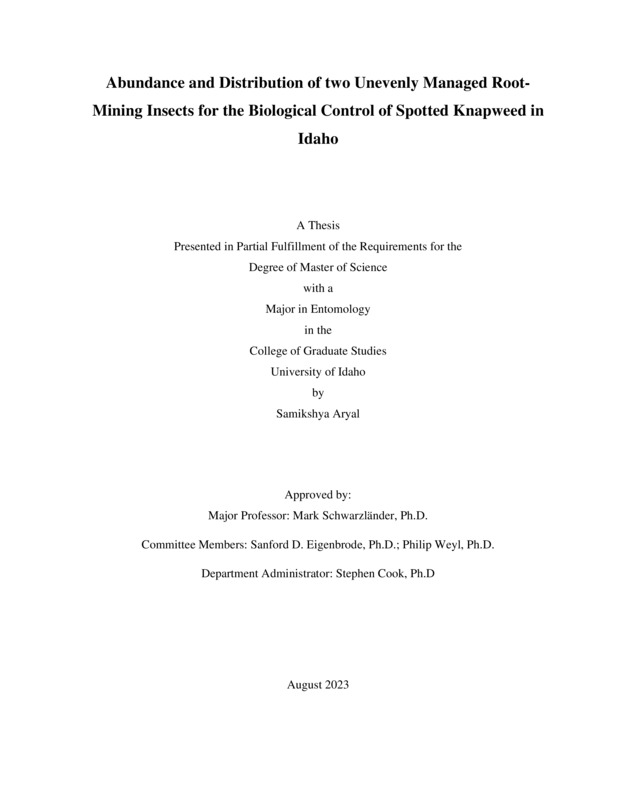Abundance and Distribution of two Unevenly Managed Root-Mining Insects for the Biological Control of Spotted Knapweed in Idaho
Aryal, Samikshya. (2023-08). Abundance and Distribution of two Unevenly Managed Root-Mining Insects for the Biological Control of Spotted Knapweed in Idaho. Theses and Dissertations Collection, University of Idaho Library Digital Collections. https://www.lib.uidaho.edu/digital/etd/items/aryal_idaho_0089n_12659.html
- Title:
- Abundance and Distribution of two Unevenly Managed Root-Mining Insects for the Biological Control of Spotted Knapweed in Idaho
- Author:
- Aryal, Samikshya
- Date:
- 2023-08
- Program:
- Entomology, Plant Path & Nematology
- Subject Category:
- Entomology
- Abstract:
-
Widespread invasive environmental weeds are managed successfully using classical biological control. Few studies are quantifying success at spatial scales, despite a standard agreement that post-release evaluation should be done consistently. Systematic post-release monitoring is equally crucial in a weed biocontrol project as pre-release host specificity testing. This thesis's second chapter examines Idaho’s unequally managed root-feeding biological control agents of Centaurea stoebe L. subsp. micranthos, an invasive herbaceous perennial plant. This research indicated that Agapeta zoegana L. (Lepidoptera: Tortricidae), a root-boring moth of C. stoebe native to Eurasia, is as prevalent as Cyphocleonus achates (Fåhr.) (Coleoptera: Curculionidae), a root-feeding weevil that is yearly grown, collected, and redistributed at a high cost to federal and state agencies. This review is intended to inform the biological control practitioners that A. zoegana is no longer uncommon as projected throughout Idaho, and moth rearing and redistribution could be considered if the rearing is feasible under semi-standardized conditions and economically viable. Chapter 2 also indicated that A. zoegana does not compete with C. achates in the field, which might cause additive damage to individual C. stoebe plants. If this effect increases to have detrimental impacts on population densities, it could enhance biological control. The severity of A. zoegana herbivory was found to decrease aboveground biomass relative to no herbivory. Chapter 3 of this thesis examines the feasibility of rearing A. zoegana in greenhouse rearing systems. Results serve as a starting point to develop more refined rearing systems based on large tubs. Our data question the continuation of C. achates rearing and redistribution initiatives.
- Description:
- masters, M.S., Entomology, Plant Path & Nematology -- University of Idaho - College of Graduate Studies, 2023-08
- Major Professor:
- Schwarzländer, Mark
- Committee:
- Eigenbrode, Sanford; Weyl, Philip; Cook, Stephen
- Defense Date:
- 2023-08
- Identifier:
- Aryal_idaho_0089N_12659
- Type:
- Text
- Format Original:
- Format:
- application/pdf
- Rights:
- In Copyright - Educational Use Permitted. For more information, please contact University of Idaho Library Special Collections and Archives Department at libspec@uidaho.edu.
- Standardized Rights:
- http://rightsstatements.org/vocab/InC-EDU/1.0/

